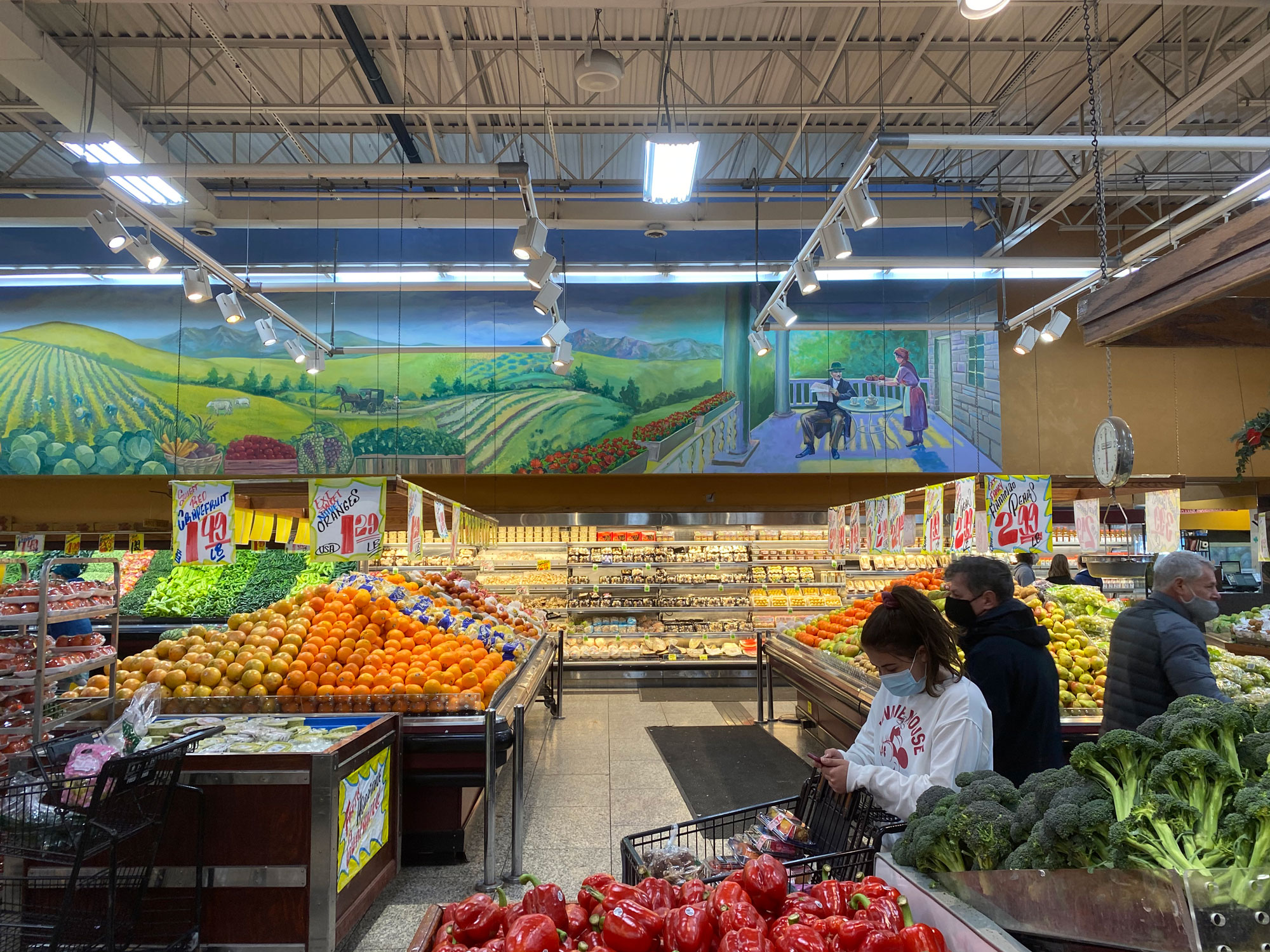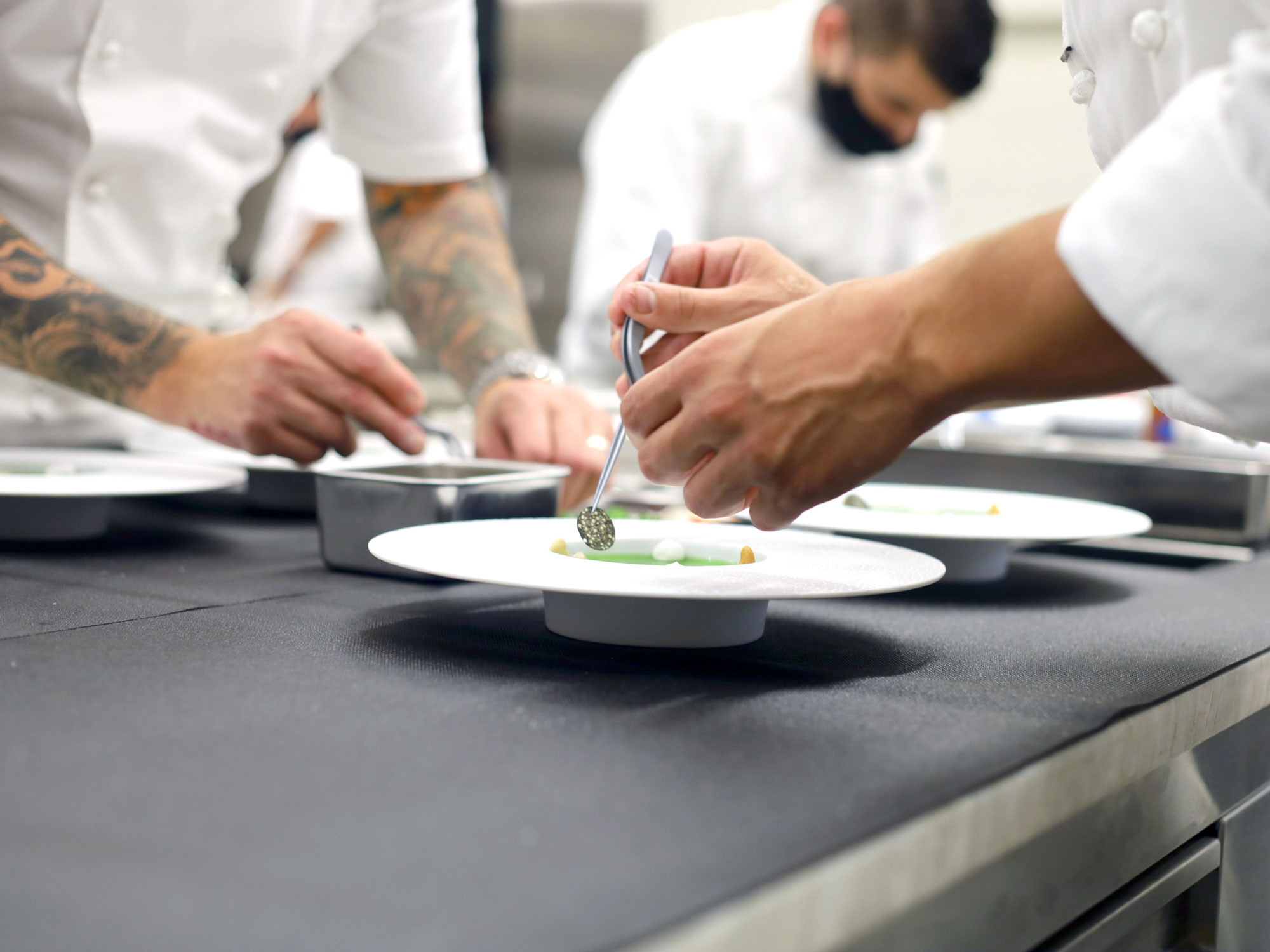“AH JEEZ, I’M 40 YEARS OLD,” NOAH SANDOVAL protests as he’s delivering a dish to our table in the kitchen. But he has no one but himself to blame for stationing his own father at the entrance to the new version of Oriole, and thus calling attention to his own relative youth. The original Oriole, 2016 to 2020, began by welcoming you into a freight elevator with a homebrewed aperitif, usually from the hands of the chef’s wife Cara. The freight elevator was your passage from the outside world, suspended and thus disconnected from the earth for a moment as you found your footing in the dining room.
When it was the chef’s wife, it was one thing, but having the chance to talk with Sandoval Senior, a former Navy Seal entirely unused to the precious world of fine dining his son inhabits, takes years off how you perceive the chef. I shot video of Noah at Schwa when he was coming up there, and again at Senza, the gluten-free kitchen he headed in Lakeview; and though someone else wrote Fooditor’s profile of then-new Oriole, I’ve dined there multiple times and followed what happened over the years. And, well, he may be 40, but to me he’s young for the mastery that this version of Oriole, reopened in July, displays.
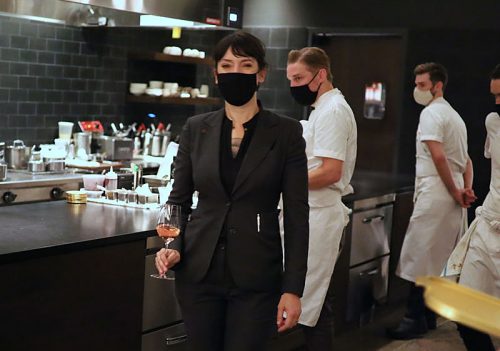
Cara Sandoval with wine; Noah behind her
Oriole took advantage of the year and a third they were closed to expand the space to meet the demand for seats at the popular restaurant, breaking into the building next door to completely transform the physical space— there are a couple of lounge spaces added, as well as (hidden behind rolling glass walls) a private dining room with a fireplace. But the big change is that the old kitchen, visible to the dining room and not especially spacious, is gone, walled off (it’s now a server work area, out of sight). Instead, there’s a new kitchen, with two banquettes, facing the kitchen like box seats at the theater—essentially kitchen tables. Like the kitchen at Smyth, the space makes no clear distinction as to where kitchen ends and guest area begins.
Officially, the border seems to be the counter which is one of your stops on the way to your table. Your evening begins at a bar just inside the new space, with a sort of cocktail, more flavorful than boozy, and a few small and delicate bites—like a tomato in some liquid scented with kabosu, a Japanese citrus, which mimics the effect of an oyster shooter. But this is just a way station, because you’re soon on to your final destination, the kitchen-dining room.
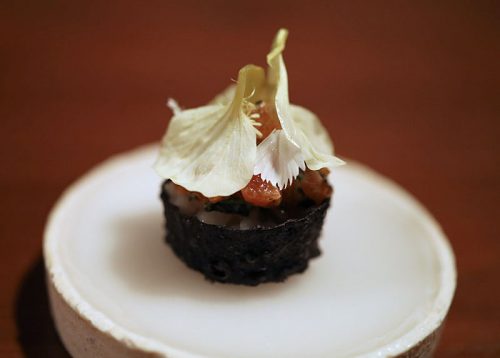
Petuna Ocean Trout Tartare with Yuzu Kosho and Nasturtium Flowers
In the kitchen another pause, at the counter demarcating the end of the kitchen. You’re poured a glass of champagne and served a kind of pastry with foie gras and a light shower of gold upon anise hyssop leaves. It’s like something a decadent wood sprite might use to tempt Girl Scouts.
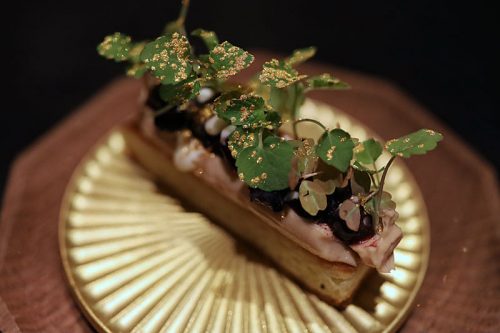
Hudson Valley Foie Gras with Huckleberry, Pink Peppercorn and Anise Hysssop
Raised Catholic, I feel an instinctive urge to kneel and cross myself before proceeding from here to the banquette. I have to admit that I’m not entirely sure what this moving about the restaurant is all about. I like seeing different sides of the restaurant—it sure beats getting a lousy table where you spend the whole night close to the restroom or being bumped into by busboys. (There are no such tables, or busboys, at Oriole.) And I can remember one occasion when I wished dinner had paused to let everyone walk around the block before continuing eating—it was at The French Laundry, where the food was heavier than expected and the room was a little warm and close, and a course of fresh air would have been welcome.
But if the stops are meant to deliver experiences that have a different feel at each point, I feel they’re still working toward that—they meet an Oriole level of consistent quality, but “consistent” is another way of saying they’re not much different from each other. There’s one playful element to the time spent at the bar—a flavored “snow” is scraped out of a blue-lit freezer and added to each bowl of one of the beginning bites—and we were all on the edges of our seats, waiting to see what was coming out of that blue light, and what it was going to be like, texturally. I won’t be surprised if there’s more of a theatrical element of surprise like that in a few months.

Ceiling over the kitchen
I SPOKE TO CURTIS DUFFY ONCE RIGHT AFTER GRACE fell apart, and he was a little excited by the chance to finally see other peoples’ kitchens and food—the person who often has the least opportunity to keep up with what’s happening in other restaurants is the working chef. When a chef gets a kitchen going again, you often see the impact of having had some months to rethink things from first principles.
At the old Oriole, the classic Noah Sandoval dish might have six or ten or 35 elements to it, but they would exist in a tightly proscribed place, detailed and bejeweled like a Fabergé egg. Tightly wound housemade pasta. An oyster within its shell, and other little tastes dotting a straight line on a cracker log. A neat box of bite-size desserts. There was a lot of geometry at the old Oriole.
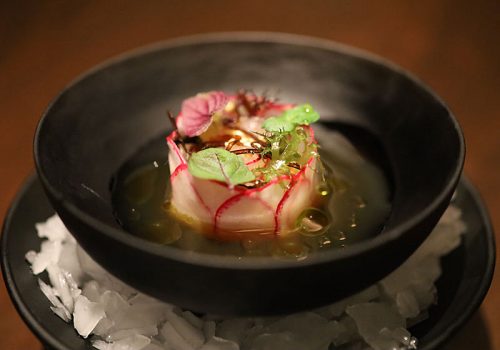
Hiramasa with Sesame, Radish and Apple
What you notice is that at the new Oriole, food breaks loose of the box, or the bowl, or the imaginary restraints of caviar stacked on sashimi. Well, sometimes, anyway—one of the first dishes is sashimi of hiramasa inside a wall of pink-edged radish slices, in an apple-flavored broth. It’s about breaking down that wall, and figuring which is vegetable and which is seafood. But the next dish is a bowl of silken tofu with young coconut and honeydew melon—a study in white and pale green—perched inside another bowl from which sprigs of leaves burst out. With just two colors to tease the eye, this dish is about texture—the soft, slippery tofu (made in house) and the firmer, slippery coconut. When Sandoval comes by a few courses later to ask how we’re doing, most of us cite this dish as a particular pleasure—a little ironic in that it’s one of the few that doesn’t have a luxe ingredient like truffle or king crab in it to justify the evening’s price. (Another standout has both.) But you’d have to be blind, or insensate in other ways, to hold that against it.
This part of the meal, which parks us at our final destination, is the heart of Oriole—no distractions of moving about, just one slam dunk wonder after another. The hunks of crab on top of a bird’s nest of slivered truffle shavings, and deeply perfumed by them. Silky sable with sweet corn amazake, downhome and exotic at once. A matsutake custard that could be soft pasta, with rippling noodles of zucchini and foie gras. The inevitable A5 wagyu, with a funky black garlic goo and a tiny piece of charred lettuce, accompanied by a trumpet mushroom consomme. Each one has a different texture to offer, a different savory note to accent the clean simplicity of the primary ingredient.
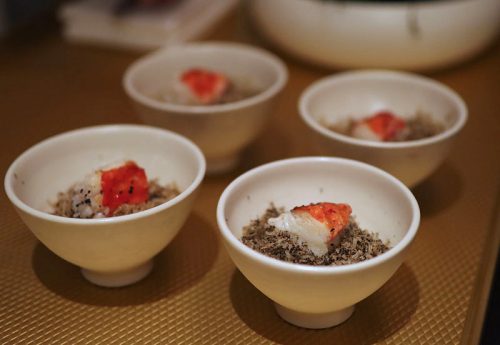
Norwegian King Crab with Black Truffle and Sabayon
Three of us at the table ordered the wine pairings, but one ordered the non-alcoholic pairings. I’m always a little suspicious of those—often they’re essentially tea pairings, but you wouldn’t pay as much for “tea” with dinner. But just as the well-chosen wines suit the dishes, the non-alcoholic pairings are surprisingly adroit at interacting with the savory flavors. The hirimasa with radish came with a German riesling, or a cold-brewed and low-brewed kabusecha, with elderflower, verjus blanc and seaweed cider vinegar. The matsutake custard came with a junmai sake—or a “toasty, genmaicha, fennel seed, maple, ginger, agave nectar.” I don’t know what half of that is, but I know what it isn’t—a quick knocking off of the non-alcoholic side to keep focus on the wine pairings.
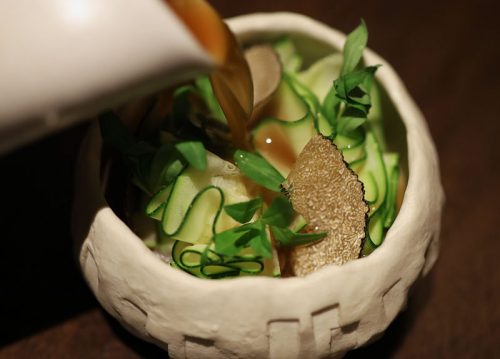
Matsutake Custard with Foie Gras, Zucchini and Black Truffle
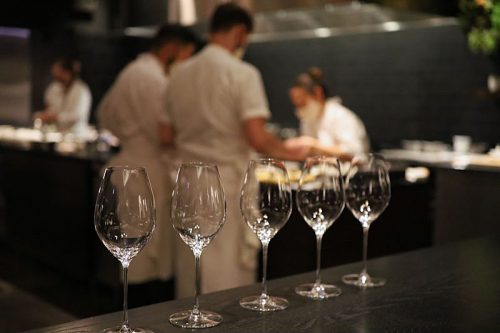
PART OF THE REASON I HESITATE TO WRITE conventional reviews is because I feel the conventions require you to say the same things over and over again. Your food arrived at the table the same night it was cooked? Your server did not, in fact, punch you at any point in the evening? A question about a dish was not greeted with sheer, deer-in-headlights terror? Then I guess service was good. Helpful. Attentive. On to the sound level. Next!
It takes a particular kind of experience to knock you out of those cliches. How much did our main server, the woman in the center of the cover photo, know the ingredients in our dishes? Well, one of them comes from her farm, that’s how well. That points to how deeply rooted everyone seemed in anything we asked about. Aaron MacManus, the sommelier, had a new associate, who proudly told us about wines she especially liked and non-alcoholic pairings she helped concoct.
But more than that, both service and cooking—which, like the kitchen and our table, seem to have no clear dividing line—were harmonious in a way that you’ve rarely seen before. All of our food came from barely a dozen feet away, but we were never aware of any stress or struggle to get it done. People worked, silently and industriously, and then food appeared in front of us for our immediate delight. At some restaurants the bustle is part of the show—look how I’m racing to keep you (and 43 other people) happy. Do you feel important? Oriole neutralizes bustle. In the past I’d have given credit for this to Cara Sandoval, whose genuine care and warmth, and the quality of her level of service, belies the fact that Oriole was her first restaurant job. But by now Oriole is big enough that one calm and collected person would not make up for other failings. There are no such failings; all of Oriole operates at a Cara level of warmth and devotion.
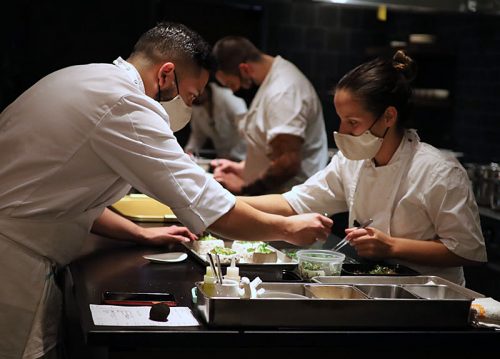
What’s a great restaurant in 2021, after that thing we’ve all been through that still shows signs of its omnipresence in masks on cooks and servers and, when we remember, guests? It’s food that delights, it’s service that comforts and decor that makes you feel swanky and in a big city. We know it has to be that. But I think in 2021, it also has to convey that you’re in a safe and welcoming place, with people who want you to appreciate what life has to offer without dwelling on what could bring it to a screeching halt and a sense of panic. A great meal makes you feel lucky for being able to go out and have it, and you’re not going to feel lucky if it can’t hide the world away and let you step off into a new one for a few hours. With preternatural calm and an extraordinary level of polish, that’s what Oriole 2.0 does.
Mr. Sandoval (if you mentioned your rank, I missed it), you can be proud of what your son is doing.
Michael Gebert is working on his upcoming oral history of Chicago restaurants, and sometimes he writes something for Fooditor.
Latest
Join the Discussion
After you comment, click Post. If you're not already logged in you will be asked to log in or register with Disqus.


